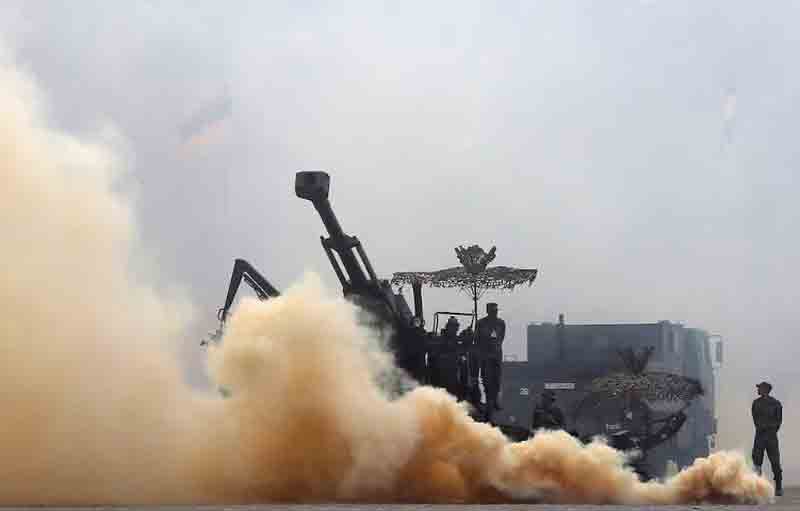In a development that could significantly alter military dynamics in the region, Indonesia has reportedly received an official request from the Russian government to station long-range military aircraft, including nuclear-capable strategic bombers, on its territory.
An international defense intelligence source indicates that Moscow is seeking permission to utilize Manuhua Air Base in Papua, Indonesia’s easternmost province, for the deployment of its long-range assets, which may include the Tu-95 ‘Bear’ strategic bomber.
The proposed location, Manuhua Air Base, shares its runway with Frans Kaisiepo International Airport, underscoring the facility’s dual-use capabilities.
Sources within the Indonesian government have confirmed to Janes that the request was submitted to Defence Minister Sjafrie Sjamsoeddin’s office following his meeting with Sergei Shoigu, the Secretary of the Security Council of the Russian Federation, in February 2025.
The request outlines Russia’s intention to base several long-range aircraft at Manuhua Air Base, which operates alongside Frans Kaisiepo Airport, as detailed in documents provided to Janes.
Strategically positioned on Biak Island, Manuhua Air Base serves as the operational center for the Indonesian Air Force’s 27th Air Squadron, which operates CN235 maritime patrol aircraft to oversee crucial sea lanes. Additionally, it is home to the newly established 9th Air Wing, a unit currently lacking an assigned aircraft fleet, potentially making it an ideal candidate for joint or foreign operations.
The Russian request did not clarify the specific type or number of aircraft that its Aerospace Forces (VKS) plan to deploy at the facility.
Sources indicated that Moscow had previously sought temporary landing rights at Manuhua for aircraft like the Tu-95 strategic bomber and the Il-76 transport, highlighting a sustained interest in establishing a logistical presence in the area. Reports also suggest that Indonesia has occasionally granted temporary permission for Russian military aircraft to operate from the base.
In a prompt response, Indonesia’s Ministry of Defence categorically denied any claims that the government had accepted a proposal from Russia to station strategic aircraft on its soil. “Regarding the reports about Russia’s proposal to use an Indonesian air base, the Ministry of Defence firmly states that this information is false,” said ministry spokesperson Frega Wenas Inkiriwang, as reported by Antara news agency.
These reports raised alarms in Canberra, with Australian Prime Minister Anthony Albanese stating, “We clearly do not want to see Russian influence in our region.” Australian Defence Minister Richard Marles confirmed that he had spoken directly with his Indonesian counterpart, who reassured him that the reports were “simply not true.”
Despite the denials, the enduring military relationship between Indonesia and Russia indicates that a more profound strategic dialogue may already be underway. A report from ABC News Australia highlighted that defense cooperation between Jakarta and Moscow has been gradually increasing over the years, especially in the military-technical sector.
In October 2024, Russian Ambassador to Jakarta Sergei Tolchenov informed TASS that military collaboration is a crucial aspect of the bilateral relationship. He remarked, “For obvious reasons, I probably will not name any specific topics or projects now. But we are working quietly in this direction. Business, diplomacy, and especially the military-technical sphere thrive on discretion. I am confident that there will be significant agreements.”
The strengthening security ties between the two countries became evident last year when Indonesia and Russia held their inaugural joint naval exercise in the Java Sea, named Latma ORRUDA 2024.
The term “ORRUDA” combines the national symbols of both nations—Orel (the Russian eagle) and Garuda (Indonesia’s mythical bird)—highlighting the significance of this collaboration. Russia’s naval contingent for the exercise included three corvettes—RFS Gromky, RFS Rezkiy, and RFS Aldar Tsydenzhapov—along with the fleet tanker RFS Pechenga, a Kamov Ka-27 anti-submarine helicopter, the Ufa (B-588) submarine on a goodwill visit, and the rescue tug Alatau.
In response, Indonesia deployed KRI I Gusti Ngurah Rai-332, KRI Frans Kaisiepo-368, an AS565 MBe Panther helicopter, and CN235 maritime patrol aircraft, with around 500 personnel engaged in coordinated maritime operations.
Manuhua Air Base, located approximately 1,200 to 1,300 kilometers northeast of Darwin, Australia, is just a two-hour flight from northern Australian shores, emphasizing its strategic importance as a forward-operating base in the Indo-Pacific region. Its proximity to Australia adds significant weight to any potential shifts in regional power dynamics.
For Russia, establishing a presence in Biak offers a range of strategic advantages with significant implications.
Firstly, Biak’s location at the intersection of the Western Pacific and the Arafura Sea provides Moscow with a crucial observation point to monitor naval and aerial movements in contested areas, including the South China Sea, Guam, and northern Australia.
Secondly, it allows Russia to effectively counter the growing influence of AUKUS—a trilateral alliance involving Australia, the United Kingdom, and the United States—especially concerning submarine technology collaboration and forward deployment strategies.
Thirdly, the air base serves as a potential launchpad for Russia’s long-range military aircraft, such as the Tu-95 and Tu-160 strategic bombers, Tu-142 maritime patrol planes, and ISR (intelligence, surveillance, reconnaissance) systems, thereby expanding Russia’s operational capabilities into the Southern Hemisphere.
Fourth, Biak’s proximity to Indonesia’s space launch facilities and resource-rich maritime areas makes it an ideal site for electronic and signals intelligence operations, which could significantly improve Moscow’s situational awareness in the region.
Lastly, for Indonesia—a country that values its non-aligned and independent foreign policy—its partnership with Russia offers a means to diversify its defense collaborations beyond conventional Western alliances.
Finally, gaining access to Biak could bolster Russia’s long-term economic goals in the Indo-Pacific, particularly in terms of securing future access to resources or logistical pathways associated with Papua’s natural riches and key maritime chokepoints.
Should this materialize, Russia’s presence at Manuhua might transform the military dynamics of the Indo-Pacific, leading to adjustments in defense strategies from the United States, Australia, and ASEAN nations, thereby altering the region’s fragile balance of power.
Discover more from Defence Talks | Defense News Hub, Military Updates, Security Insights
Subscribe to get the latest posts sent to your email.





